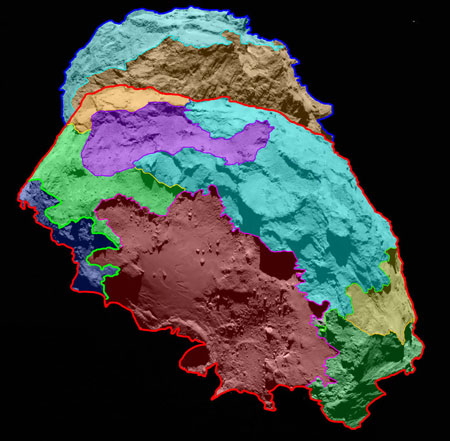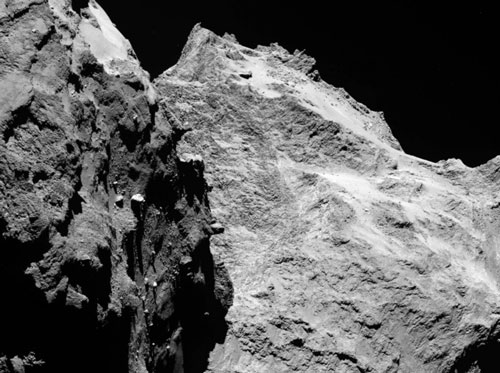| Sep 10, 2014 |
A map of Rosetta's comet
|
|
(Nanowerk News) High-resolution images of comet 67P/Churyumov-Gerasimenko reveal a unique, multifaceted world. ESA's Rosetta spacecraft arrived at its destination about a month ago and is currently accompanying the comet as it progresses on its route toward the inner solar system. Scientists have now analyzed images of the comet's surface taken by OSIRIS, Rosetta's scientific imaging system, and allocated several distinct regions, each of which is defined by special morphological characteristics. This analysis provides the basis for a detailed scientific description of 67P's surface.
|
 |
| Jagged cliffs and prominent boulders: In this image, several of 67P's very different surface structures become visible. The left part of the images shows the side wing of the comet's "body", while the right is the back of its "head". The image was taken by OSIRIS, Rosetta's scientific imaging system, on September 5th, 2014 from a distance of 62 kilometers. One pixel corresponds to 1.1 meters. (Image: ESA/Rosetta/MPS for OSIRIS Team MPS/UPD/LAM/IAA/SSO/INTA/UPM/DASP/IDA) (click on image to enlarge)
|
|
"Never before have we seen a cometary surface in such detail“, says OSIRIS Principal Investigator Holger Sierks from the Max Planck Institute for Solar System Science in Germany. In some of the images, one pixel corresponds to 75 centimeters scale on the nucleus. "It is a historic moment, we have an unprecedented resolution to map a comet“, he adds.
|
|
With areas dominated by cliffs, depressions, craters, boulders or even parallel grooves, 67P displays a multitude of different terrains. While some of these areas appear to be quiet, others seem to be shaped by the comet's activity. As OSIRIS images of the comet's coma indicate, the dust that 67P casts into space is emitted there.
|
 |
| In this view of the "belly" and part of the "head" of the comet, several morphologically different regions are indicated. (Image: ESA/Rosetta/MPS for OSIRIS Team MPS/UPD/LAM/IAA/SSO/INTA/UPM/DASP/IDA) (click on image to enlarge)
|
|
"This first map is, of course, only the beginning of our work“, says Sierks. "At this point, nobody truely understands, how the morphological variations we are currently witnessing came to be.“ As both 67P and Rosetta travel closer to the Sun in the next months, the OSIRIS team will monitor the surface looking for changes. While the scientists do not expect the borderlines of the comet's regions to vary dramatically, even subtle transformations of the surface may help to explain how cometary activity created such a breathtaking world. The maps will also offer valuable insights for Rosetta's Lander Team and the Rosetta orbiter scientists to determine a primary and backup landing site from the earlier preselection of five candidates.
|

